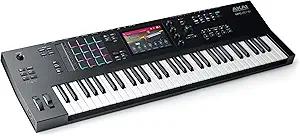Akai Professional MPC Key 61 review exploring its synthesizer performance and music production features
Akai Professional MPC Key 61 review exploring its synthesizer performance and music production features
- The semi-weighted keys with aftertouch provide an exceptional tactile experience, making it ideal for nuanced performances.
- The 7-inch multi-touch display simplifies navigation and ensures quick access to features.
- Built-in 6000+ customizable sounds offer endless possibilities for creating unique compositions.
- Wireless connectivity via Wi-Fi and Bluetooth enables seamless integration with other tools or software.
- Expandable internal storage with an additional SSD bay ensures ample space for extensive projects.
As an Amazon Associate I earn from qualifying purchases.
Description
A Hands-On Experience with the Akai Professional MPC Key 61
Testing the Akai Professional MPC Key 61, I found myself immersed in a world of music production possibilities that felt both expansive and intuitive. This standalone music production synthesizer keyboard is more than just an instrument; it’s a studio powerhouse packed into a sleek, well-designed chassis. From its 61-key semi-weighted keybed with aftertouch to the 16 velocity-sensitive RGB drum pads, everything about this product screams versatility and creativity. Let me walk you through my experience using it, including the good, the not-so-good, and how it stacks up against competitors.
Design and Build Quality
The MPC Key 61 has a design that blends form and function beautifully. The semi-weighted keys feel responsive and are perfect for dynamic playing, whether you’re working on delicate piano parts or energetic synth lines. The 7-inch multi-touch display is another standout, offering a smooth and intuitive interface for navigating through plugins, mixing tracks, and tweaking effects. I especially appreciated the assignable touch strip controller, which allowed me to manipulate sounds in real time—a feature that added a tactile element to sound shaping.
Its connectivity options are nothing short of impressive. With USB, MIDI In/Out/Thru, and 8 CV/Gate jacks, I could connect everything from vintage synths to modern MIDI controllers. The built-in Wi-Fi and Bluetooth also made integrating it with Ableton Link and updating the OS seamless. However, I couldn’t ignore the fact that its plastic body, while durable, didn’t feel as premium as some metal-bodied synthesizers I’ve used.
Breakthrough in Sound Engines
The 20+ sound engines and over 6,000 customizable presets are where this product truly shines. Whether I needed lush orchestral strings, punchy drum kits, or an array of synth textures, the MPC Key 61 delivered. The sound quality is pristine, and the 24-bit audio interface ensures clarity, even when connecting external microphones or instruments. It’s also equipped with high-end preamps and AD/DA converters, which added a professional touch to my recordings.
One feature I couldn’t stop exploring was the MPC Stems, which allowed me to isolate drums, bass, and vocals from any sample. It was a game-changer for remixing and reimagining tracks. That said, I did experience a slight learning curve with the linear song arranger in MPC3 mode, especially when trying to transition from traditional DAW workflows.
Key Benefits
- Impressive sound library: Over 6,000 presets and 20+ sound engines.
- Versatility: Seamless connection with vintage and modern gear.
- Standalone functionality: Perfect for creating and performing without a computer.
- Real-time control options: Touch strip, Q-Link knobs, and pitch/modulation wheels.
Areas for Improvement
- Plastic chassis: Lacks the premium feel of some competitors.
- Learning curve: MPC3 features might feel overwhelming at first.
- Storage limitations: Although expandable, the 32GB internal storage fills up quickly.
How It Stacks Up Against Competitors
Comparing the MPC Key 61 to other synthesizer keyboards like the Roland Fantom or Yamaha Montage, I found it to hold its own exceptionally well. The standalone capability is a huge win, as many competitors rely heavily on external computers to unlock their full potential. Additionally, the MPC workflow is iconic and remains unmatched for beat-making and sampling.
However, while the sound engines and plugin integration are phenomenal, the Yamaha Montage excels in preset realism, especially for acoustic instruments. Meanwhile, the Roland Fantom offers a more robust build quality and a slightly more intuitive interface for live performance. That said, neither competitor matches the all-in-one studio versatility of the MPC Key 61.
Quality for Price
In terms of cost-efficiency, the MPC Key 61 offers immense value for its features. It’s not just a keyboard; it’s a complete production ecosystem with DAW integration, multi-track recording, and live performance capabilities. While it’s not the cheapest option, the versatility and sound quality make it worth every penny for serious producers and performers.
Would I recommend it? Absolutely, especially for anyone looking to combine sound design, beat-making, and live performance in one device. It’s a tool that inspires creativity and eliminates the need for multiple pieces of gear, making it a solid investment for any music producer or musician.
Additional information
| Item Weight | 17.88 pounds |
|---|---|
| Product Dimensions | 12.4 x 38.86 x 3.54 inches |
| Country of Origin | Taiwan |
| Item model number | MPC Key 61 |
| Is Discontinued By Manufacturer | No |
| Color Name | Black |
| Connector Type | USB |
| Hardware Interface | USB |
| Supported Software | Any Digital Audio Workstation compatible with Windows / Mac OS |
| Material Type | Plastic |
| Musical Style | Electronic |
| Number of Keyboard Keys | 61 |
| Size | MPC Key 61 |
| Proficiency Level | Professional |
| Power Source | Corded Electric |










